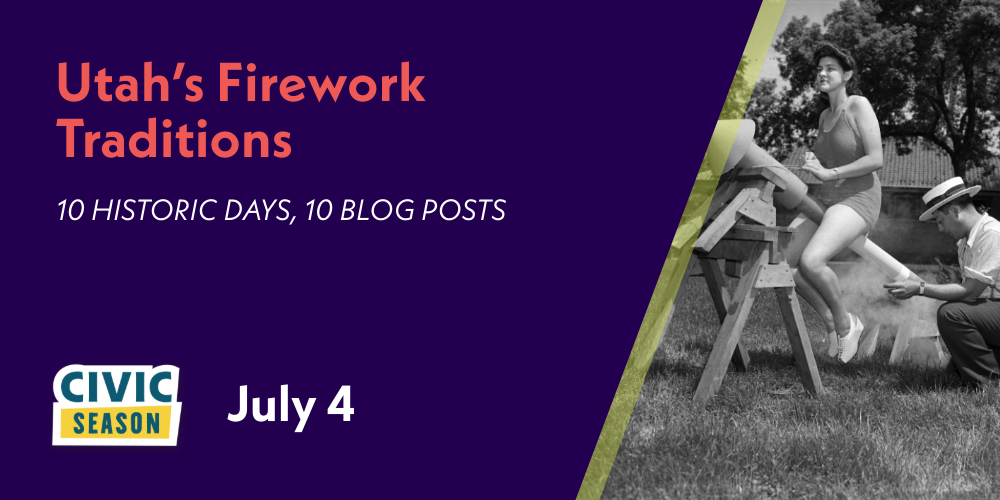One of the most iconic ways to end a full day of Fourth of July activities is a good old-fashioned firework show. The flashes, booms, and whiffs of smoke have become synonymous with our national holiday, including here in Utah. Between the Fourth of July and the state holiday of Pioneer Day, fireworks have become a beloved Utah tradition, gathering together communities across the state during July. This tradition goes all the way back to the earliest Independence Day celebrations.
On July 3, 1776, John Adams wrote to his wife, Abigail, that he hoped American independence would be celebrated by succeeding generations “with shows, games, sports, guns, bells, bonfires, and illuminations.” Adams did not mention fireworks (in this case, “illuminations” refers to placing candles in the window), but fireworks have become an iconic — perhaps the most iconic — element of Independence Day. Fireworks have been part of Fourth of July celebrations since the very first one in 1777.
When Euro-Americans arrived in Utah in the 1840s and 1850s, fireworks were not readily available, so early Fourth of July celebrations of the 1850s involved cannons and guns but not pyrotechnics. Fireworks began to make their way into the Utah Territory in the 1860s, and Utahns had more access to fireworks especially after the transcontinental railroad was completed in 1869.

Fireworks not only invoke a sense of celebration, awe, and excitement, but they are often used as the focal point of many holiday gatherings, creating a shared experience and sense of community as people wait together in anticipation for the spectacle to begin.
Even though fireworks are fun and exciting, there is still debate over whether they are the best choice for commemorating our nation’s birthday. As firework use increased, so did firework accidents. In 1893, one Utahn penned a strongly worded op-ed arguing that lighting fireworks was “a practice for which no good can be said. . . . Is any good accomplished, any useful lesson taught, any real amusement obtained by it? If there is, we pity the intellect that is capable of appreciating it. It would be better in our opinion to do without the holiday than to have the fireworks and the noise.”
The opinion might seem extreme, but the writer was concerned about burned property and, more tragically, children who were maimed or killed from firework accidents. He had recently participated in the burial of a young girl who died from firework burns. Indeed, fireworks seemed to have had inconsistent safety standards. An 1897 newspaper article expected that “purely electrical fireworks” would eventually replace more dangerous fireworks.

MSS C 400 Salt Lake Tribune Negative Collection, Independence Day–Fireworks, Utah Historical Society.
Concerned about firework safety, Utah passed a law in 1939 that only permitted public firework shows by organizations, meaning that private citizens could not light their own fireworks. However, this law often went unenforced. In 1983, the state once again legalized private pyrotechnics, hoping that residents would buy tamer fireworks legally in the state, rather than buy more dangerous ones out of state.
Today, “purely electrical fireworks” have finally become a reality, as drone shows become more popular, and many cities host drone shows due to fire danger and air quality concerns. However, traditional fireworks still remain a significant part of Fourth of July and Pioneer Day celebrations. Under current Utah law, it is legal to light fireworks July 2–5 and July 22–25.
Though fireworks are a fun and beloved tradition, they do pose dangerous risks, so we all have the responsibility to keep our communities safe by following guidelines like these:
- Avoid lighting them on “Red Flag Days” (dry, windy days)
- Supervise children around fireworks and other fires
- Place fireworks on stable surfaces without vegetation
- Light one at a time
- Douse used fireworks in water
- Use fireworks only in approved areas
We can each do our part to keep ourselves and our neighbors safe. Whether you choose to celebrate with fireworks, sparklers, or drones, remember you are a part of a long American tradition of commemoration envisioned by John Adams in 1776.

Sources:
- Len Travers, Celebrating the Fourth: Independence Day and the Rites of Nationalism in the Early Republic (University of Massachusetts Press, 1997), 15, 18, 21–22.
- See, for example, “The Celebration of the Fourth of July,” Deseret News, July 12, 1851, 291; “Fourth of July at the Capitol,” Deseret News, August 7, 1852, [4].
- See, for example, “No Procession,” Daily Telegraph (Salt Lake City), July 4, 1864, [3]; “Independence Day,” Daily (Corinne) Utah Reporter, July 3/4, 1870, [3]; Adam Criblez, Parading Patriotism: Independence Day Celebrations in the Urban Midwest, 1826–1876 (Northern Illinois University Press, 2013), 107.
- “Barbarism Is Not Patriotism,” Juvenile Instructor, July 15, 1893, 445–46.
- “Barbarism Is Not Patriotism,” 445–46.
- “Two Million Dollars’ Worth of Fireworks,” Salt Lake Herald, July 4, 1897, 18.
- “Fourth to Be Sanest if All Obey Law,” Salt Lake Tribune, June 26, 1939, 18.
- Anne Wilson, “Safety Issue: Relax or Toughen Utah Law on Fireworks?,” Salt Lake Tribune, June 19, 1980, H3; Douglas L. Parker, “Panel Forwards Fireworks Act,” Salt Lake Tribune, February 5, 1981, 6A; Dawn Tracy, “Make Sure This 4th of July Is a Safe and Sane One,” Salt Lake Tribune, July 2, 1983, A8.

